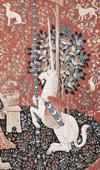- unicorn
-
/yooh"ni kawrn'/, n.1. a mythical creature resembling a horse, with a single horn in the center of its forehead: often symbolic of chastity or purity.2. a heraldic representation of this animal, in the form of a horse with a lion's tail and with a long, straight, and spirally twisted horn.4. an animal mentioned in the Bible, Deut. 33:17: now believed by some to be a description of a wild ox or rhinoceros.5. a former gold coin of Scotland, first issued by James III in 1486, having an obverse bearing the figure of a unicorn.[1175-1225; ME unicorne ( < OF) < L unicornis one-horned, equiv. to uni- UNI- + corn(u) HORN + -is adj. suffix]
* * *
Mythological animal resembling a white horse with a single horn on its forehead.The unicorn was depicted in Mesopotamian art and was referred to in the ancient myths of India and China. Its earliest description in Greek literature dates from с 400 BC and probably refers to the Indian rhinoceros. The unicorn was believed to be fierce and difficult to capture, but if a virgin were brought before it, it would lay its head in the virgin's lap. Its horn was thought to offer protection against poison. Medieval writers associated the unicorn with Jesus, and the hunt for the unicorn was often represented in medieval art. Unicorn, detail from "The Lady and the Unicorn" tapestry, late 15th century; in the ...Giraudon/Art Resource
Unicorn, detail from "The Lady and the Unicorn" tapestry, late 15th century; in the ...Giraudon/Art Resource* * *
▪ mythological creaturemythological animal resembling a horse or a kid with a single horn on its forehead. The unicorn appeared in early Mesopotamian artworks, and it also was referred to in the ancient myths of India and China. The earliest description in Greek literature of a single-horned (Greek: monokerōs; Latin: unicornis) animal was by the historian Ctesias (c. 400 BC), who related that the Indian wild ass was the size of a horse, with a white body, purple head, and blue eyes; on its forehead was a cubit-long horn coloured red at the pointed tip, black in the middle, and white at the base. Those who drank from its horn were thought to be protected from stomach trouble, epilepsy, and poison. It was very fleet of foot and difficult to capture. The actual animal behind Ctesias' description was probably the Indian rhinoceros.Certain poetical passages of the biblical Old Testament refer to a strong and splendid horned animal called reʾem. This word was translated “unicorn” or “rhinoceros” in many versions of the Bible, but many modern translations prefer “wild ox” (aurochs), which is the correct meaning of the Hebrew reʾem. As a biblical animal the unicorn was interpreted allegorically in the early Christian church. One of the earliest such interpretations appears in the ancient Greek bestiary known as the Physiologus, which states that the unicorn is a strong, fierce animal that can be caught only if a virgin maiden is thrown before it. The unicorn leaps into the virgin's lap, and she suckles it and leads it to the king's palace. Medieval writers thus likened the unicorn to Christ, who raised up a horn of salvation for mankind and dwelt in the womb of the Virgin Mary. Other legends tell of the unicorn's combat with the elephant, whom it finally spears to death with its horn, and of the unicorn's purifying of poisoned waters with its horn so that other animals may drink.Cups reputedly made of unicorn horn but actually made of rhinoceros horn or narwhal tusk were highly valued by important persons in the Middle Ages as a protection against poisoned drinks. Many fine representations of the hunt of the unicorn survive in medieval art, not only in Europe but also in the Islāmic world and in China.* * *
Universalium. 2010.
